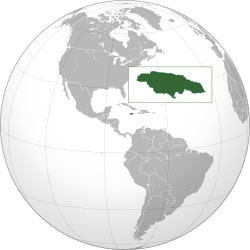Portal:Jamaica
The Jamaica Portal
Jamaica is an island country in the Caribbean Sea and the West Indies. At 10,990 square kilometres (4,240 sq mi), it is the third-largest island—after Cuba and Hispaniola—of the Greater Antilles and the Caribbean. Jamaica lies about 145 km (78 nmi) south of Cuba, 191 km (103 nmi) west of Hispaniola (the island containing Haiti and the Dominican Republic), and 215 km (116 nmi) southeast of the Cayman Islands (a British Overseas Territory). With 2.8 million people,0 Jamaica is the third most populous Anglophone country in the Americas (after the United States and Canada), and the fourth most populous country in the Caribbean. Kingston is the country's capital and largest city. Most Jamaicans are of Sub-Saharan African ancestry, with significant European, East Asian (primarily Chinese), Indian, Lebanese, and mixed-race minorities. Because of a high rate of emigration for work since the 1960s, there is a large Jamaican diaspora, particularly in Canada, the United Kingdom, and the United States. The country has a global influence that belies its small size; it was the birthplace of the Rastafari religion and reggae music (and such associated genres as dub, ska, and dancehall); and it is internationally prominent in sports, including cricket, sprinting, and athletics. Jamaica has sometimes been considered the world's least populous cultural superpower. (Full article...) Selected article -Winston Rodney OD (born 1 March 1945), better known by the stage name Burning Spear, is a Jamaican roots reggae singer-songwriter, vocalist, and musician. Burning Spear is a Rastafarian and one of the most influential and long-standing roots artists to emerge from the 1970s. (Full article...) Did you know (auto-generated)
Selected biography -Michael Lee-Chin OJ OOnt (born 3 January 1951) is a Jamaican-Canadian billionaire businessman, philanthropist and the chairman and CEO of Portland Holdings Inc, a privately held investment company in Ontario, Canada. Lee-Chin was appointed to the Order of Ontario in 2017. (Full article...) General images -The following are images from various Jamaica-related articles on Wikipedia.
This is a Good article, an article that meets a core set of high editorial standards.
Lenford "Steve" Harvey was a Jamaican activist who campaigned for the rights of those living with HIV/AIDS in Jamaican society. In November 2005, he was abducted from his home and murdered in a robbery that some commentators believed was also a homophobic hate crime. Harvey, an openly gay man, had worked for Jamaica AIDS Support for Life (JASL), since 1997 becoming the group's coordinator for Kingston. In this position, he focused on distributing information and services surrounding HIV/AIDS to the most marginalised sectors of Jamaican society, among them prisoners, sex workers, and lesbian, gay, bisexual, and transgender (LGBT) people. In 2005, he was selected as Jamaica's project coordinator for the Latin America and Caribbean Council of AIDS Service Organizations. Harvey was praised for his work. According to Peter Tatchell of the British LGBT rights organisation OutRage!, "It is thanks to the efforts of Steve and his colleagues that many Jamaican men and women - both gay and straight - have not contracted HIV. They have helped save hundreds of lives." In November 2005, three men carrying guns broke into Harvey's home, removing any valuables they could find. They asked him if he was gay, and when he refused to respond to them, they kidnapped him, later shooting him dead and dumping the body elsewhere. The police subsequently arrested four individuals and charged them with murder in the furtherance of a robbery. The accused remained in police custody for almost ten years before the case came to court. At that point, the police dropped their murder charges against two of the accused. The other two, Dwayne Owen and Andre West, went on trial and were found unanimously guilty of murder by a jury. Although prosecutors had requested capital punishment in the case, the judge instead sentenced them to life in prison with a minimum of thirty years before becoming eligible for parole. They remain in prison, as of 2022. (Full article...) Selected picture -Selected cuisines, dishes and foods -Jerk is a style of cooking native to Jamaica, in which meat is dry-rubbed or wet-marinated with a hot spice mixture called Jamaican jerk spice. The technique of jerking (or cooking with jerk spice) originated from Jamaica's indigenous peoples, the Arawak and Taíno tribes, and was adopted by the descendants of 17th-century Jamaican Maroons who intermingled with them. (Full article...)
More did you know
Selected listsTopicsCategoriesRelated portals
WikiProjectsGeographical:
History and Society:
Tasks
Associated WikimediaThe following Wikimedia Foundation sister projects provide more on this subject:
More portals
| ||||||||||||






















































